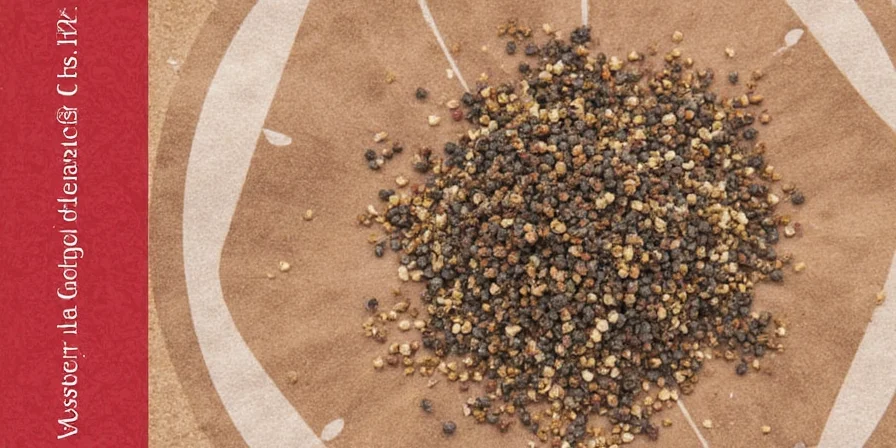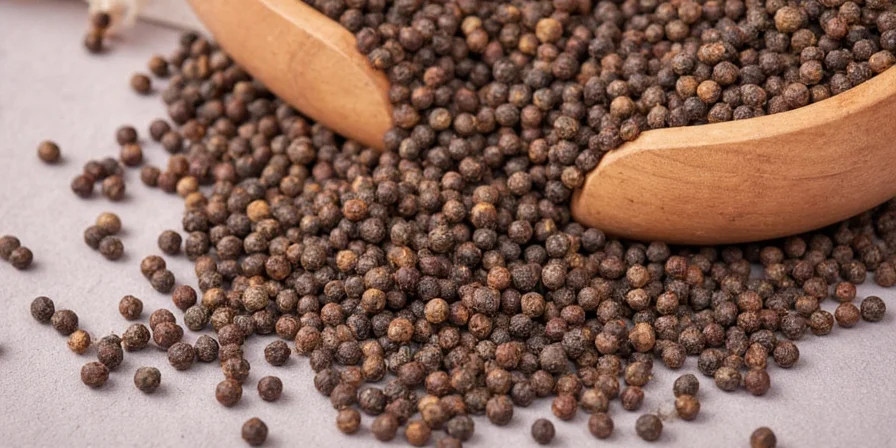The Global Journey of Peppercorn: A Culinary Connoisseur’s Guide to Storage and Usage

Image Caption: The black peppercorn plant, native to the Maluku Islands of Indonesia, has been a global spice trade staple for centuries.
Introduction: Peppercorn — The Spice That Changed the World
Peppercorn is not just a spice — it's a historical phenomenon. Once so valuable that it was used as currency in ancient Rome, pepper has shaped trade routes, wars, and even the rise of empires. But for today’s modern culinary enthusiasts, the real question is: how do we store and use peppercorn like a pro?
Whether you're a seasoned chef or a curious home cook, mastering the art of peppercorn storage and usage can elevate your dishes from good to extraordinary. In this blog, we'll take a deep dive into the origins of peppercorn, explore the best ways to store it, and share clever hacks for using it in your kitchen. So let's get started on this spicy journey!
Where Does Peppercorn Come From?
Peppercorn, also known as Piper nigrum, is a fruit that comes from the evergreen vine of the same name. This vine is native to the Maluku Islands of Indonesia, also known as the Spice Islands. However, today, peppercorn is cultivated in various regions around the world, including India, Vietnam, Brazil, and Sri Lanka.
| Origin | Common Varieties | Flavor Profile |
|---|---|---|
| Maluku Islands (Indonesia) | Black, Green, White | Earthy, sharp, slightly bitter |
| India | Black, Green | Spicy, warm |
| Vietnam | Black, Green | Smoky, complex |
| Brazil | Black | Strong, pungent |
| Sri Lanka | Black | Subtle, balanced |
Each region brings its own unique flavor profile to the peppercorn, depending on soil, climate, and processing techniques. For example, Vietnamese peppercorn is often smoky and complex, while Brazilian peppercorn tends to be stronger and more pungent. Understanding these nuances can help you choose the right peppercorn for your recipes.
Peppercorn Storage: The Ultimate Guide
Proper storage is key to preserving the potency and flavor of peppercorn. Here are some practical tips to ensure your peppercorn stays fresh for as long as possible:
1. Keep It Cool and Dry
- Store peppercorn in an airtight container in a cool, dark place, like a pantry or spice cabinet.
- Avoid exposure to heat and moisture, which can cause the peppercorn to lose its flavor and aroma.
Tip: If you're using peppercorn frequently, consider keeping a small jar on your countertop for easy access, and a larger jar in your pantry for long-term storage.
2. Avoid Light and Air
- Light and air are the enemies of spice. Oxygen can cause oxidation, which dulls the flavor of peppercorn over time.
- Use opaque or dark-colored containers to protect your peppercorn from light.
Tip: Mason jars with screw-on lids are excellent for storage, as they are airtight and easy to clean.
3. Freeze for Long-Term Storage
- If you have a large quantity of peppercorn that you won't use in the near future, consider freezing it in a sealed container or resealable bag.
- Freezing can help preserve the flavor and aroma of peppercorn for up to a year or more.
Tip: Freeze peppercorn in small portions so you can easily take out what you need without exposing the rest to air.
4. Grind It Fresh, Whenever Possible
- Whole peppercorns have a longer shelf life than ground peppercorn, which loses its potency quickly once exposed to air.
- Grind your peppercorn just before using it to ensure maximum flavor and aroma.
Tip: Invest in a high-quality pepper mill with a ceramic grinder for the best results. It preserves the oils and flavor of the peppercorn better than a steel grinder.
Peppercorn Usage: 10 Clever Hacks for the Kitchen
Now that your peppercorn is properly stored, it's time to get creative in the kitchen. Here are 10 clever hacks to help you use peppercorn like a pro:
1. Use It in Marinades
Peppercorn adds a bold kick to marinades. Try adding a few crushed peppercorns to your next beef or pork marinade for a deep, earthy flavor.
2. Make a Peppercorn Paste
Mix whole peppercorns with a bit of oil and salt to create a paste that can be used as a rub or spread. This is a great way to add depth to roasted vegetables or grilled meats.
3. Use It in Sauces
Peppercorn is a fantastic addition to sauces like béarnaise, gravy, and even homemade mayonnaise. It adds a subtle heat and complexity that elevates the dish.
4. Pair It with Sweet Flavors
Peppercorn pairs surprisingly well with sweet flavors. Try adding a pinch of crushed peppercorn to chocolate truffles or caramel sauce for a unique twist.
5. Use It in Baking
Yes, you read that right — peppercorn can be used in baking. A small amount of crushed peppercorn can add a surprising depth to spiced cakes, cookies, or even bread.
6. Brew a Peppercorn Tea
Peppercorn tea is a traditional remedy in many cultures. Simply steep crushed peppercorns in hot water for a few minutes and enjoy a warming, slightly spicy drink.
7. Use It in Pickling
Peppercorn can be used to flavor pickled vegetables. Add a few whole peppercorns to your pickling brine for a subtle kick and added depth.
8. Add It to Soups and Stews
Peppercorn is a great addition to hearty soups and stews. It adds a warm, spicy note that complements the richness of the dish.
9. Use It in Curing Meats
Peppercorn is a common ingredient in curing meats like sausages and charcuterie. It adds a bold, spicy flavor that enhances the overall taste of the meat.
10. Use It in Cocktails
Peppercorn can be used to add a unique twist to cocktails. Try muddling a few crushed peppercorns into a cocktail for a bold, spicy flavor.
Peppercorn Varieties: A Comparative Guide
There are several types of peppercorn, each with its own unique flavor and usage. Here’s a quick guide to help you choose the right one for your recipe:
| Type | Processing Method | Flavor | Best For |
|---|---|---|---|
| Black Peppercorn | Unripe green peppercorns are dried in the sun | Sharp, pungent, slightly bitter | Most common use — marinades, sauces, and general cooking |
| Green Peppercorn | Unripe green peppercorns are preserved in brine or alcohol | Fresh, tangy, and slightly sweet | Use in sauces, pastes, and as a garnish |
| White Peppercorn | Black peppercorns are soaked and the outer layer is removed | Milder, earthy, and less pungent | Use in light-colored dishes, such as mashed potatoes or white sauces |
Choosing the right type of peppercorn can make a big difference in your cooking. Black peppercorn is the most versatile and commonly used, while green peppercorn is best for fresh, tangy flavors. White peppercorn is milder and better suited for light-colored dishes.
Peppercorn in Global Cuisines: A Flavorful Journey
Peppercorn is a staple in many global cuisines, from Indian curries to French sauces. Here’s a quick look at how different cultures use peppercorn in their cooking:
- Indian Cuisine: Peppercorn is a key ingredient in many Indian spice blends, such as garam masala and panch phoron. It adds a sharp, spicy kick to curries, stews, and chutneys.
- French Cuisine: French chefs often use black peppercorn in sauces like béarnaise and mayonnaise. It adds a subtle heat and complexity that enhances the flavor of the dish.
- Thai Cuisine: Thai cuisine uses green peppercorn in curries and soups. It adds a fresh, tangy flavor that complements the other ingredients.
- Chinese Cuisine: Chinese cuisine uses peppercorn in stir-fries, braised dishes, and hot pots. It adds a bold, spicy flavor that enhances the overall taste of the dish.
Peppercorn is a versatile spice that can be used in a variety of cuisines. Whether you're cooking Indian curries or French sauces, peppercorn can add a unique depth of flavor to your dishes.
Conclusion: Mastering Peppercorn — A Flavorful Journey
Peppercorn is more than just a spice — it's a flavor powerhouse with a rich history and a global footprint. By understanding its origins, mastering its storage, and exploring its culinary uses, you can elevate your cooking to new heights.
Remember: proper storage is key to preserving the potency and flavor of peppercorn. Keep it cool, dry, and away from light. And when it comes to usage, don’t be afraid to get creative. Whether you're using it in marinades, sauces, or even cocktails, peppercorn can add a bold, spicy kick to your dishes.
So go ahead — explore, experiment, and enjoy the global journey of peppercorn in your kitchen. Your taste buds will thank you!

Image Caption: From marinades to cocktails, peppercorn is a versatile spice with countless culinary uses.
Further Reading
If you're interested in learning more about other spices and their storage and usage, be sure to check out our other blogs on the subject. Happy cooking!










 浙公网安备
33010002000092号
浙公网安备
33010002000092号 浙B2-20120091-4
浙B2-20120091-4